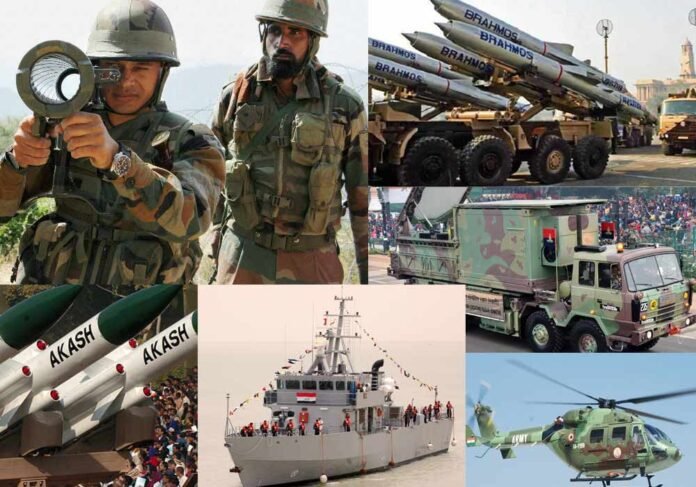India has seen a remarkable surge in defence exports trajectory with thirty times more exports over the last decade. There has been a phenomenal 78 per cent rise in the first quarter of 2024-25 with exports amounting to Rs 6,915 crore, up from Rs 3885 crore for the same duration of the preceding year.
The exports to Russia reached a historical high in June 2024, recording $475 million as compared to $378 million for the same month a year earlier. Is this a future indicator of turning the scales from a net importer in the defence sector to a net exporter? This success story will not only boost the Viksit Bharat initiative but also showcase the potential of its defence industrial base and ecosystem.
The success can be attributable to a host of internal policy initiatives, the maturing of the private sector and external geopolitical factors which have boosted the demands of the global defence industry.
Indian defence exports have witnessed a phenomenal 78 per cent rise in the first quarter of 2024-25 with exports amounting to Rs 6,915 crore, up from Rs 3,885 crore for the same duration of the preceding year
This demand has also escalated by the ongoing conflicts such as the Russia-Ukraine war and the Israel-Hamas conflict, which have spurred several nations to bolster their national defence capabilities.
India, with its potent defence industry, has both the opportunity and capability to be one of the top global suppliers of the future.
India has enunciated a visionary export strategy placing formidable goals, inclusive of accomplishing a turnover of Rs 1.75 lakh crore ($25 billion) in defence production by 2025 and exporting Rs 35,000 crore ($5 billion) in aerospace and defence exports by using 2025, reflecting the seriousness of this endeavour.
Recognising the significance of self-reliance, self-sufficiency and indigenisation for both strategic and financial purposes, the government has increased its investment in Research and Development and defence manufacturing capacity.
This success is attributable to a host of internal policy initiatives, the maturing of the private sector and external geopolitical factors which have boosted the demands of the global defence industry
The government has implemented numerous policies to enhance defence exports, as an economic growth engine. A dedicated export-promoting body now advises on export strategy, and policies and coordinates defence exhibitions. The Defence Export Steering Committee oversees and monitors export permissions and manifestations.
At the same time as defence exports have emerged as a key part of India’s defence diplomacy, its embassies are now actively promoting them overseas. The Offset Policy has been revised, and export rules have been streamlined to facilitate exports.
India’s defence export portfolio has diversified both in inventory and export base, catering to the desires of over 90 countries globally. The variety of exported items consists of the BRAHMOS supersonic cruise missile, having drawn interest from several countries including the Philippines.
India’s defence exports are strategically aligned with its diplomatic and foreign policy in furtherance of its national interests. The US has emerged as the largest defence export destination for India
India has made large strides in exporting aircraft and helicopters. The HAL Dhruv superior light helicopter (ALH) and the Light Combat Aircraft (LCA) Tejas have found customers in nations like Ecuador, Mauritius, and the Philippines.
India’s defence exports encompass sniper rifles, specialised sight systems, bulletproof jackets, and helmets. Both the state-owned and private sectors have successfully exported ammunition to Myanmar, Israel, and Armenia.
Fast assault vessels, patrol boats, and offshore patrol vessels are part of India’s naval export inventory to nations in Southeast Asia and Africa, furthering India’s strategic interests in these regions.
While India’s defence exports have seen exponential growth, numerous challenges still hinder its path. India faces intense competition from giant defence exporters like the US, Russia, and France
India has additionally been exporting sophisticated electronic warfare equipment, communication systems, and radars indigenously developed.
India’s defence exports are strategically aligned with its diplomatic and foreign policy in furtherance of its national interests. The US has emerged as the largest defence export destination for India, accounting for almost 50 per cent of India’s overall defence export volume.
The US defence industry sources over one billion dollars’ worth of systems, subsystems, and components from India yearly, feeding into their global delivery chains. Companies like Boeing and Lockheed Martin, through joint ventures with Indian corporations, were pivotal in this increase.
The geopolitical dynamics of the Indo-Pacific security architecture have fostered defence ties, with India exporting several army items, from missiles to small arms.
The government has implemented numerous policies to enhance defence exports, as an economic growth engine. A dedicated export-promoting body now advises on export strategy, and policies and coordinates defence exhibitions
Africa has been a favoured market destination for Indian export, with Mauritius, Seychelles, and Nigeria finding favour with Indian defence equipment.
India has also extended easy credits to the Global South and a diplomatic push, aiming to further its interest in the continent. India’s defence exports to West Asian market locations like Oman and the UAE are part of a broader strategy to strengthen ties in the strategically important region.
The Indian authorities have played an essential role in propelling defence exports via numerous policy reforms including the Defence Production and Export Promotion Policy (DPEPP) 2020, which outlines the roadmap for enhanced defence production and fostering exports.
Simplified Licensing and Approval Processes have extensively streamlined the procedure for granting export licenses, making it less complicated for companies to export defence items.
The creation of the Open General Export License (OGEL) has in addition simplified the export of certain categories of defence items. The Line of Credit (LoC) Facilities have been extended to friendly nations, facilitating the purchase of Indian defence items.
The government has encouraged greater private sector participation in defence manufacturing. Companies like Indo-MIM are now India’s largest defence exporter, and exports defence materials to over 50 nations globally.
India’s defence exports encompass sniper rifles, specialised sight systems, bulletproof jackets, and helmets. Both the state-owned and private sectors have successfully exported ammunition to Myanmar, Israel, and Armenia
While India’s defence exports have seen exponential growth, numerous challenges still hinder its path. India faces intense competition from giant defence exporters like the US, Russia, and France.
These nations have an enormous defence industrial base and advanced technology, which India has to compete with. While Indian defence products are competitive in price, the qualitative challenges in an international market remain.
It is here that India needs to gain trust and showcase credibility. Addressing these issues is crucial for enhancing India’s international canvas. Building a robust supply chain and offering comprehensive after-sales services is important for preserving long-term relationships with its exporters.
While Indian defence products are competitive in price, the qualitative challenges in an international market remain. It is here that India needs to gain trust and showcase credibility
India needs to be internationally competitive especially when it comes to big platforms beyond just spares and components. Transfer of technology is another area along with offset rules to attract more partners, thereby improving its competitive index in the global market.
Additionally, bureaucratic lethargy, technology mapping and sustained quality assurance remain impediments to integrate the private sector into India’s defence innovation and industrial ecosystem.
A robust defence industrial base with a resilient private sector based on a model of ‘risk sharing-gain sharing’ is still to be fully realised. Such a defence industrial base requires sufficient budgetary allocation and investment in defence R&D that produces globally competitive products.
The test for India will be achieving sale of Indigenous big-ticket products at competitive prices and high technology with assured quality and backup
In essence, India’s defence exports are still evolving, but the stage is well set and the trajectory is most encouraging to achieve its ambitious goals. Its global footprints in defence exports and recognition, particularly in the US, Africa, and Southeast Asia, has reinvigorated its defence ecosystem.
The test for India will be achieving sale of Indigenous big-ticket products at competitive prices and high technology with assured quality and backup. The future of being a top-class defence exporter looks promising and evolving, in its role of being a major contributor to the country’s economy and global standing.
…
The author, a PVSM, AVSM, VSM has had an illustrious career spanning nearly four decades. A distinguished Armoured Corps officer, he has served in various prestigious staff and command appointments including Commander Independent Armoured Brigade, ADG PP, GOC Armoured Division and GOC Strike 1. The officer retired as DG Mechanised Forces in December 2017 during which he was the architect to initiate process for reintroduction of Light Tank and Chairman on the study on C5ISR for Indian Army. Subsequently he was Consultant MoD/OFB from 2018 to 2020. He is also a reputed defence analyst, a motivational speaker and prolific writer on matters of military, defence technology and national security. The views expressed are personal and do not necessarily carry the views of Raksha Anirveda
The author, a PVSM, AVSM, VSM has had an illustrious career spanning nearly four decades. A distinguished Armoured Corps officer, he has served in various prestigious staff and command appointments including Commander Independent Armoured Brigade, ADG PP, GOC Armoured Division and GOC Strike 1. The officer retired as DG Mechanised Forces in December 2017 during which he was the architect to initiate process for reintroduction of Light Tank and Chairman on the study on C5ISR for Indian Army. Subsequently he was Consultant MoD/OFB from 2018 to 2020. He is also a reputed defence analyst, a motivational speaker and prolific writer on matters of military, defence technology and national security. The views expressed are personal and do not necessarily carry the views of Raksha Anirveda










